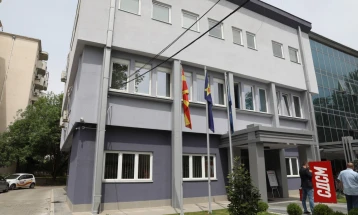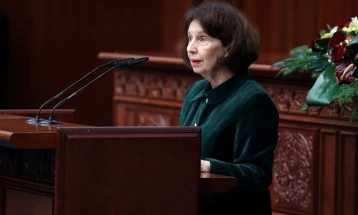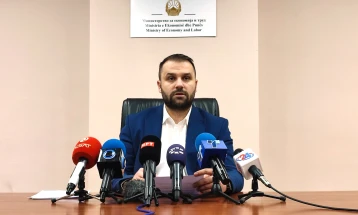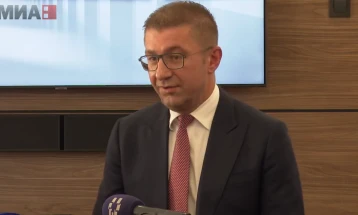Each prisoner costs the country EUR 9,500 on average
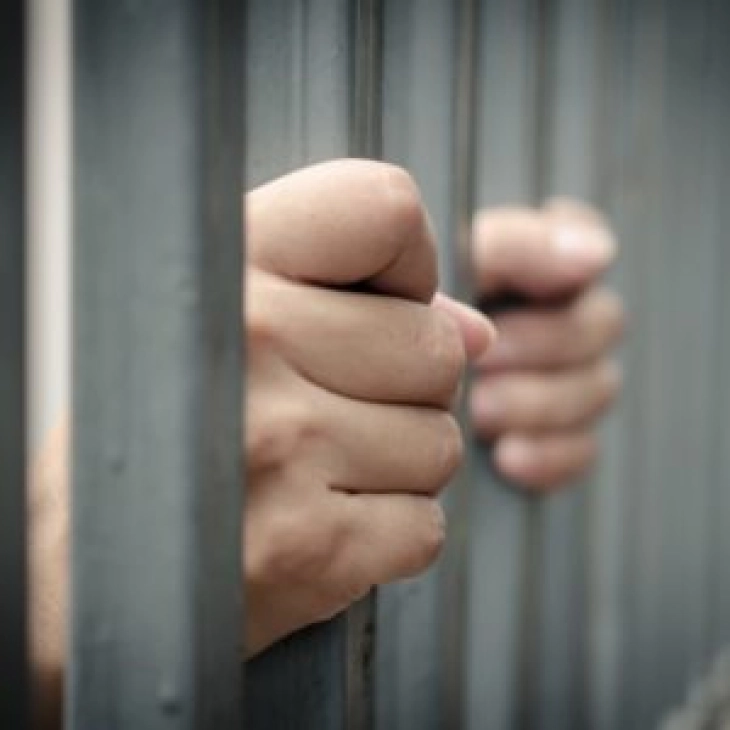
Skopje, 29 May 2021 (MIA) - According to the data of the Department for Execution of Sanctions, as seen by MIA, the total sum awarded for all penitentiaries and the juvenile detention center in Tetovo is MKD 1,119,634,000 (EUR 18.2 million). Of that, half is meant for the prison police and officers – MKD 556,675 - and around 18% (199,500,000) is meant for improving prison conditions.
There were 1,901 prisoners in 2020, filling out 89% of the overall prison capacity which is 2,113 people, as per the Department, giving each person 4 m2 or 9 m3 of space on average.
Therefore, each prisoner costs the country MKD 588,000 or EUR 9,500 on a yearly basis on average.
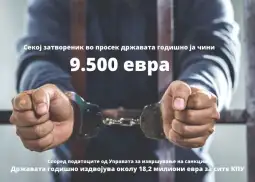 MIA discovered that, while the overall capacity of prisons around the country in 2020 was not fully filled out, three prisons are overcrowded: Shtip, where there were 225 persons in a 139-person facility, a 161% increase; Tetovo, where there are 70 people in a 48-person facility – 145% increase, and Prilep with a 102% increase with 111 people in a 102-person facility.
The Helsinki Committee for Human Rights tells MIA that even though there have been some improvements in prisons, mostly in regards of improving the material conditions, the penitentiary system is still facing big problems and challenges.
“There are issues regarding material conditions, healthcare, education and resocialization of convicted individuals. Additionally, they often submit complaints to the Helsinki Committee regarding use of excessive force by prison officers, and it takes strengthening the efficacy and effectiveness of the external mechanism to eliminate all cases of torture and inhuman behavior,” the Committee says.
Among other things, this is in the Committee’s 2020 anti-torture report in which it says that the Republic of North Macedonia is supposed to set up a professional prison service and improve prison conditions.
MIA discovered that, while the overall capacity of prisons around the country in 2020 was not fully filled out, three prisons are overcrowded: Shtip, where there were 225 persons in a 139-person facility, a 161% increase; Tetovo, where there are 70 people in a 48-person facility – 145% increase, and Prilep with a 102% increase with 111 people in a 102-person facility.
The Helsinki Committee for Human Rights tells MIA that even though there have been some improvements in prisons, mostly in regards of improving the material conditions, the penitentiary system is still facing big problems and challenges.
“There are issues regarding material conditions, healthcare, education and resocialization of convicted individuals. Additionally, they often submit complaints to the Helsinki Committee regarding use of excessive force by prison officers, and it takes strengthening the efficacy and effectiveness of the external mechanism to eliminate all cases of torture and inhuman behavior,” the Committee says.
Among other things, this is in the Committee’s 2020 anti-torture report in which it says that the Republic of North Macedonia is supposed to set up a professional prison service and improve prison conditions.
 Marjan Spasovski, Head of the Department for Execution of Sanctions, says they carefully analyzed the report.
“The main complaints are related to healthcare and accommodation capacities, not just the professionalization of the prison police. That is why, around the end of July, we will issue a tender to reconstruct the penitentiaries, where we will build a new closed ward and the existing old facility, the oldest one in Idrizovo, will be torn down and a new prison ward will be built, and the second building will be about building a laundry room, a kitchen and a detention ward,” Spasovski says.
Marjan Spasovski, Head of the Department for Execution of Sanctions, says they carefully analyzed the report.
“The main complaints are related to healthcare and accommodation capacities, not just the professionalization of the prison police. That is why, around the end of July, we will issue a tender to reconstruct the penitentiaries, where we will build a new closed ward and the existing old facility, the oldest one in Idrizovo, will be torn down and a new prison ward will be built, and the second building will be about building a laundry room, a kitchen and a detention ward,” Spasovski says.
 The number of prisoners dropping; prisons in Shtip, Tetovo and Prilep overcrowded
The prison population in the country is going down nationwide, but the problem with overcrowding in prisons in Shtip and Tetovo is repeating itself.
The overall number of prisoners in 2017 was 2,763, an 130% increase in capacity. This number is in a steady decline, so from a rate of prisons being 92% full in 2018, 91% in 2019, it’s down to 1901 prisoner or 89% fullness in 2020.
The prison in Tetovo is also facing overcrowding. It can house 48 prisoners, but 70 prisoners were incarcerated there in 2020, which is an 145% occupancy rate, having grown from 2019 when there were 66 prisoners and a 137% occupancy rate.
The prisons in Ohrid, Gevgelija, Struga and Kumanovo have the least occupancy, with 14% in Ohrid, 57% in Gevgelija, 76% in Struga and Kumanovo.
The number of prisoners dropping; prisons in Shtip, Tetovo and Prilep overcrowded
The prison population in the country is going down nationwide, but the problem with overcrowding in prisons in Shtip and Tetovo is repeating itself.
The overall number of prisoners in 2017 was 2,763, an 130% increase in capacity. This number is in a steady decline, so from a rate of prisons being 92% full in 2018, 91% in 2019, it’s down to 1901 prisoner or 89% fullness in 2020.
The prison in Tetovo is also facing overcrowding. It can house 48 prisoners, but 70 prisoners were incarcerated there in 2020, which is an 145% occupancy rate, having grown from 2019 when there were 66 prisoners and a 137% occupancy rate.
The prisons in Ohrid, Gevgelija, Struga and Kumanovo have the least occupancy, with 14% in Ohrid, 57% in Gevgelija, 76% in Struga and Kumanovo.
 Spasovski says that this is due to the typification and prison network in North Macedonia.
“Shtip is a closed-type penitentiary, so is Tetovo and the Idrizovo juvenile center. Shtip is a central prison that covers the entirety of eastern Macedonia and the overcrowding is due to the fact that the referral acts from the primary courts from all of eastern Macedonia go primarily to Shtip,” Spasovski says, adding that the situation is similar with Prilep, unfortunately.
Spasovski says that this is due to the typification and prison network in North Macedonia.
“Shtip is a closed-type penitentiary, so is Tetovo and the Idrizovo juvenile center. Shtip is a central prison that covers the entirety of eastern Macedonia and the overcrowding is due to the fact that the referral acts from the primary courts from all of eastern Macedonia go primarily to Shtip,” Spasovski says, adding that the situation is similar with Prilep, unfortunately.
 “We’re talking about closed capacities, because housing capacities in semi-open institutions and closed institutions such as penitentiaries, we have sufficient capacities, but we’re talking about semi-open and open facilities, and our closed facilities are overcrowded, it’s like that in Idrizovo too,” he says.
The Helsinki Committee says that there’s no overcrowding in penitentiaries for now, but Idrizovo and Shtip are at risk.
“We noted this during our penitentiary visits from August-October 2020. The application of alternative measures as a replacement for a prison sentence will lead to a long-term solution of this issue, i.e. reducing overcrowding, and it’ll improve prison conditions too,” they say.
The Department for Execution of Sanctions says that certain safety conditions must be fulfilled before moving prisoners to prisons where there is more room.
“We’re negotiating for the Ohrid prison to become a semi-open facility. The Prilep penitentiary was renamed from a penitentiary facility to a home, and we’re thinking to make one of the existing semi-open prisons a closed type facility, but there are safety conditions to be fulfilled,” Spasovski says.
North Macedonia has 105 prisoners per 100,000 people, Montenegro has 172, Croatia 84
According to data from the Worlds Prison Brief, at the London Institute of Crime and Justice Policy Research, North Macedonia had 2,175 prisoners, including people in custody, or 105 prisoners per 100,000 citizens. 3.3% of them are women, 0.1% are underage, and 6.5% are foreign citizens.
“We’re talking about closed capacities, because housing capacities in semi-open institutions and closed institutions such as penitentiaries, we have sufficient capacities, but we’re talking about semi-open and open facilities, and our closed facilities are overcrowded, it’s like that in Idrizovo too,” he says.
The Helsinki Committee says that there’s no overcrowding in penitentiaries for now, but Idrizovo and Shtip are at risk.
“We noted this during our penitentiary visits from August-October 2020. The application of alternative measures as a replacement for a prison sentence will lead to a long-term solution of this issue, i.e. reducing overcrowding, and it’ll improve prison conditions too,” they say.
The Department for Execution of Sanctions says that certain safety conditions must be fulfilled before moving prisoners to prisons where there is more room.
“We’re negotiating for the Ohrid prison to become a semi-open facility. The Prilep penitentiary was renamed from a penitentiary facility to a home, and we’re thinking to make one of the existing semi-open prisons a closed type facility, but there are safety conditions to be fulfilled,” Spasovski says.
North Macedonia has 105 prisoners per 100,000 people, Montenegro has 172, Croatia 84
According to data from the Worlds Prison Brief, at the London Institute of Crime and Justice Policy Research, North Macedonia had 2,175 prisoners, including people in custody, or 105 prisoners per 100,000 citizens. 3.3% of them are women, 0.1% are underage, and 6.5% are foreign citizens.
 In the countries of the region, the most prisoners per 100,000 citizens are in Montenegro – 172, Albania – 164, Serbia – 158. Then, Bulgaria with 109, Greece with 107, Kosovo with 103 and Croatia with 84 per 100,000 citizens.
The most prisoners per 100,000 in Europe are in Belarus – 345, Turkey – 335, Russia – 330, whereas the least prisoners per 100,000 citizens are in Germany – 69, 53 in Norway and 33 in Iceland.
As international monitoring missions state that there is overcrowding in prisons in our country, alternate measures are intensely applied in the world that will significantly relax penitentiary facilities.
Aleksandar Atanasov
Angela Rajchevska
Photos by Frosina Naskovikj
Translated by Dragana Knezhevikj
In the countries of the region, the most prisoners per 100,000 citizens are in Montenegro – 172, Albania – 164, Serbia – 158. Then, Bulgaria with 109, Greece with 107, Kosovo with 103 and Croatia with 84 per 100,000 citizens.
The most prisoners per 100,000 in Europe are in Belarus – 345, Turkey – 335, Russia – 330, whereas the least prisoners per 100,000 citizens are in Germany – 69, 53 in Norway and 33 in Iceland.
As international monitoring missions state that there is overcrowding in prisons in our country, alternate measures are intensely applied in the world that will significantly relax penitentiary facilities.
Aleksandar Atanasov
Angela Rajchevska
Photos by Frosina Naskovikj
Translated by Dragana Knezhevikj
 MIA discovered that, while the overall capacity of prisons around the country in 2020 was not fully filled out, three prisons are overcrowded: Shtip, where there were 225 persons in a 139-person facility, a 161% increase; Tetovo, where there are 70 people in a 48-person facility – 145% increase, and Prilep with a 102% increase with 111 people in a 102-person facility.
The Helsinki Committee for Human Rights tells MIA that even though there have been some improvements in prisons, mostly in regards of improving the material conditions, the penitentiary system is still facing big problems and challenges.
“There are issues regarding material conditions, healthcare, education and resocialization of convicted individuals. Additionally, they often submit complaints to the Helsinki Committee regarding use of excessive force by prison officers, and it takes strengthening the efficacy and effectiveness of the external mechanism to eliminate all cases of torture and inhuman behavior,” the Committee says.
Among other things, this is in the Committee’s 2020 anti-torture report in which it says that the Republic of North Macedonia is supposed to set up a professional prison service and improve prison conditions.
MIA discovered that, while the overall capacity of prisons around the country in 2020 was not fully filled out, three prisons are overcrowded: Shtip, where there were 225 persons in a 139-person facility, a 161% increase; Tetovo, where there are 70 people in a 48-person facility – 145% increase, and Prilep with a 102% increase with 111 people in a 102-person facility.
The Helsinki Committee for Human Rights tells MIA that even though there have been some improvements in prisons, mostly in regards of improving the material conditions, the penitentiary system is still facing big problems and challenges.
“There are issues regarding material conditions, healthcare, education and resocialization of convicted individuals. Additionally, they often submit complaints to the Helsinki Committee regarding use of excessive force by prison officers, and it takes strengthening the efficacy and effectiveness of the external mechanism to eliminate all cases of torture and inhuman behavior,” the Committee says.
Among other things, this is in the Committee’s 2020 anti-torture report in which it says that the Republic of North Macedonia is supposed to set up a professional prison service and improve prison conditions.
 Marjan Spasovski, Head of the Department for Execution of Sanctions, says they carefully analyzed the report.
“The main complaints are related to healthcare and accommodation capacities, not just the professionalization of the prison police. That is why, around the end of July, we will issue a tender to reconstruct the penitentiaries, where we will build a new closed ward and the existing old facility, the oldest one in Idrizovo, will be torn down and a new prison ward will be built, and the second building will be about building a laundry room, a kitchen and a detention ward,” Spasovski says.
Marjan Spasovski, Head of the Department for Execution of Sanctions, says they carefully analyzed the report.
“The main complaints are related to healthcare and accommodation capacities, not just the professionalization of the prison police. That is why, around the end of July, we will issue a tender to reconstruct the penitentiaries, where we will build a new closed ward and the existing old facility, the oldest one in Idrizovo, will be torn down and a new prison ward will be built, and the second building will be about building a laundry room, a kitchen and a detention ward,” Spasovski says.
 The number of prisoners dropping; prisons in Shtip, Tetovo and Prilep overcrowded
The prison population in the country is going down nationwide, but the problem with overcrowding in prisons in Shtip and Tetovo is repeating itself.
The overall number of prisoners in 2017 was 2,763, an 130% increase in capacity. This number is in a steady decline, so from a rate of prisons being 92% full in 2018, 91% in 2019, it’s down to 1901 prisoner or 89% fullness in 2020.
The prison in Tetovo is also facing overcrowding. It can house 48 prisoners, but 70 prisoners were incarcerated there in 2020, which is an 145% occupancy rate, having grown from 2019 when there were 66 prisoners and a 137% occupancy rate.
The prisons in Ohrid, Gevgelija, Struga and Kumanovo have the least occupancy, with 14% in Ohrid, 57% in Gevgelija, 76% in Struga and Kumanovo.
The number of prisoners dropping; prisons in Shtip, Tetovo and Prilep overcrowded
The prison population in the country is going down nationwide, but the problem with overcrowding in prisons in Shtip and Tetovo is repeating itself.
The overall number of prisoners in 2017 was 2,763, an 130% increase in capacity. This number is in a steady decline, so from a rate of prisons being 92% full in 2018, 91% in 2019, it’s down to 1901 prisoner or 89% fullness in 2020.
The prison in Tetovo is also facing overcrowding. It can house 48 prisoners, but 70 prisoners were incarcerated there in 2020, which is an 145% occupancy rate, having grown from 2019 when there were 66 prisoners and a 137% occupancy rate.
The prisons in Ohrid, Gevgelija, Struga and Kumanovo have the least occupancy, with 14% in Ohrid, 57% in Gevgelija, 76% in Struga and Kumanovo.
 Spasovski says that this is due to the typification and prison network in North Macedonia.
“Shtip is a closed-type penitentiary, so is Tetovo and the Idrizovo juvenile center. Shtip is a central prison that covers the entirety of eastern Macedonia and the overcrowding is due to the fact that the referral acts from the primary courts from all of eastern Macedonia go primarily to Shtip,” Spasovski says, adding that the situation is similar with Prilep, unfortunately.
Spasovski says that this is due to the typification and prison network in North Macedonia.
“Shtip is a closed-type penitentiary, so is Tetovo and the Idrizovo juvenile center. Shtip is a central prison that covers the entirety of eastern Macedonia and the overcrowding is due to the fact that the referral acts from the primary courts from all of eastern Macedonia go primarily to Shtip,” Spasovski says, adding that the situation is similar with Prilep, unfortunately.
 “We’re talking about closed capacities, because housing capacities in semi-open institutions and closed institutions such as penitentiaries, we have sufficient capacities, but we’re talking about semi-open and open facilities, and our closed facilities are overcrowded, it’s like that in Idrizovo too,” he says.
The Helsinki Committee says that there’s no overcrowding in penitentiaries for now, but Idrizovo and Shtip are at risk.
“We noted this during our penitentiary visits from August-October 2020. The application of alternative measures as a replacement for a prison sentence will lead to a long-term solution of this issue, i.e. reducing overcrowding, and it’ll improve prison conditions too,” they say.
The Department for Execution of Sanctions says that certain safety conditions must be fulfilled before moving prisoners to prisons where there is more room.
“We’re negotiating for the Ohrid prison to become a semi-open facility. The Prilep penitentiary was renamed from a penitentiary facility to a home, and we’re thinking to make one of the existing semi-open prisons a closed type facility, but there are safety conditions to be fulfilled,” Spasovski says.
North Macedonia has 105 prisoners per 100,000 people, Montenegro has 172, Croatia 84
According to data from the Worlds Prison Brief, at the London Institute of Crime and Justice Policy Research, North Macedonia had 2,175 prisoners, including people in custody, or 105 prisoners per 100,000 citizens. 3.3% of them are women, 0.1% are underage, and 6.5% are foreign citizens.
“We’re talking about closed capacities, because housing capacities in semi-open institutions and closed institutions such as penitentiaries, we have sufficient capacities, but we’re talking about semi-open and open facilities, and our closed facilities are overcrowded, it’s like that in Idrizovo too,” he says.
The Helsinki Committee says that there’s no overcrowding in penitentiaries for now, but Idrizovo and Shtip are at risk.
“We noted this during our penitentiary visits from August-October 2020. The application of alternative measures as a replacement for a prison sentence will lead to a long-term solution of this issue, i.e. reducing overcrowding, and it’ll improve prison conditions too,” they say.
The Department for Execution of Sanctions says that certain safety conditions must be fulfilled before moving prisoners to prisons where there is more room.
“We’re negotiating for the Ohrid prison to become a semi-open facility. The Prilep penitentiary was renamed from a penitentiary facility to a home, and we’re thinking to make one of the existing semi-open prisons a closed type facility, but there are safety conditions to be fulfilled,” Spasovski says.
North Macedonia has 105 prisoners per 100,000 people, Montenegro has 172, Croatia 84
According to data from the Worlds Prison Brief, at the London Institute of Crime and Justice Policy Research, North Macedonia had 2,175 prisoners, including people in custody, or 105 prisoners per 100,000 citizens. 3.3% of them are women, 0.1% are underage, and 6.5% are foreign citizens.
 In the countries of the region, the most prisoners per 100,000 citizens are in Montenegro – 172, Albania – 164, Serbia – 158. Then, Bulgaria with 109, Greece with 107, Kosovo with 103 and Croatia with 84 per 100,000 citizens.
The most prisoners per 100,000 in Europe are in Belarus – 345, Turkey – 335, Russia – 330, whereas the least prisoners per 100,000 citizens are in Germany – 69, 53 in Norway and 33 in Iceland.
As international monitoring missions state that there is overcrowding in prisons in our country, alternate measures are intensely applied in the world that will significantly relax penitentiary facilities.
Aleksandar Atanasov
Angela Rajchevska
Photos by Frosina Naskovikj
Translated by Dragana Knezhevikj
In the countries of the region, the most prisoners per 100,000 citizens are in Montenegro – 172, Albania – 164, Serbia – 158. Then, Bulgaria with 109, Greece with 107, Kosovo with 103 and Croatia with 84 per 100,000 citizens.
The most prisoners per 100,000 in Europe are in Belarus – 345, Turkey – 335, Russia – 330, whereas the least prisoners per 100,000 citizens are in Germany – 69, 53 in Norway and 33 in Iceland.
As international monitoring missions state that there is overcrowding in prisons in our country, alternate measures are intensely applied in the world that will significantly relax penitentiary facilities.
Aleksandar Atanasov
Angela Rajchevska
Photos by Frosina Naskovikj
Translated by Dragana Knezhevikj 



